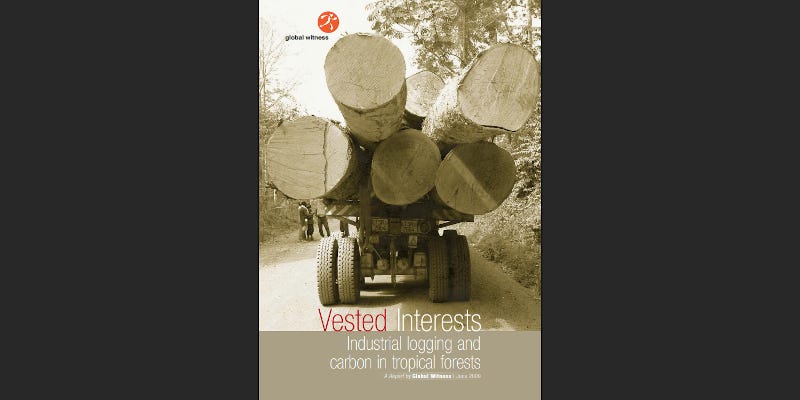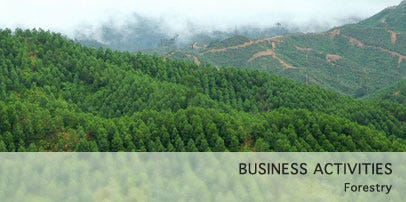“We practice Sustainable Forest Management,” states Malaysian logging company Rimbunan Hijau on its website. We know that Rimbunan Hijau’s claims to sustainability are nonsense, of course. As if to make the point, the company illustrates its claim with a photograph of a monoculture tree plantation:
In a 2006 report, Greenpeace describes Rimbunan Hijau’s operations as “Thirty years of forest plunder” and notes that “Rimbunan Hijau is responsible for many large scale destructive logging operations”. But the fact that even Rimbunan Hijau can claim to be carrying out sustainable forest management illustrates that the term is little more than a fig leaf for industrial logging – business as usual.
Yet at the UN climate negotiations, the term “sustainable forest management” is increasingly being used in the REDD negotiations.
For example, the draft decision that came out of the Subsidiary Body for Scientific and Technological Advice at the UN climate negotiations in Bonn (1-12 June 2009) states:
Acknowledging the importance of reducing emissions from deforestation and forest degradation, and the role of conservation, sustainable management of forests and enhancement of forest carbon stocks in developing countries,
[ . . . ]
Recognizing the importance of promoting sustainable management of forests and co-benefits, including biodiversity, that may complement the aims and objectives of national forest programmes and relevant international conventions and agreements,
A report by Global Witness, launched in June 2009 during the Bonn negotiations, points out that in fact “Industrial logging under the guise of ‘Sustainable Forest Management (SFM)’ is a major source of carbon emissions, a primary driver of deforestation and threatens to derail the UN process to reduce deforestation.” The report, “Vested Interests: Industrial logging and carbon in tropical forests” documents how reduced impact logging (the most benign form of commercial logging) kills 5-10 non-target trees for every target tree cut, “and releases between 10 and 80 tonnes of carbon per hectare”.
It doesn’t stop there. The roads built through forests by logging companies (which are needed whether they are practising reduced impact logging or forest plunder) makes the forests between 4 and 8 times more likely to be completely deforested than intact forests. Even worse is the fact that the risk of fire is massively increased by logging. “All forms of logging make forests more vulnerable to fire,” notes Global Witness.
During the El Niño events in the late 1990s, 60% of logged forests in Indonesian Borneo went up in smoke compared with 6% of primary forest. In fact, the increase in forest fires caused by logging can be more devastating and release more carbon than the logging operations themselves.
It is not only logging companies that are pushing for the inclusion of sustainable forest management in REDD. One of the main drivers is the Collaborative Partnership on Forests, a group of thirteen organisations, including all the UN organisations involved in the negotiations on forests and climate. Members include the Climate Change Convention Secretariat, the UN Forum on Forests, the UN Food and Agriculture Organisation, the Convention on Biodiversity, the International Tropical Timber Organisation and the World Bank.
Global Witness lists a series of key findings and recommendations in the report, including the following:
If REDD is to be an effective mitigation tool, funds must not be used to benefit or subsidise industrial logging operations.
There is no consensus on the meaning of ‘sustainable forest management’. Many destructive logging practices have taken place under its name.
Industrial logging in tropical forests, in all its forms, is not a sustainable option that helps to solve climate change. Rather, it is a major cause of degradation and a precursor to deforestation and conversion to other uses, such as industrial agriculture.
The carbon implications of “reduced impact” logging (RIL) should always be assessed against the carbon dynamics of an intact forest, not by comparing it with worst-case destructive logging operations.
The assumption that a forest logged selectively will remain a forest is incorrect. Selectively logged forests are, in fact, more likely to be converted to other land use than undisturbed forest.
The amount of carbon stored long-term in wood products derived from natural tropical forests is negligible compared with the carbon emissions resulting from the harvest, transport and processing of the wood.
Introducing ‘harvested wood products’ into accounting and reporting procedures under the UNFCCC would constitute a methodological nightmare and is best avoided.







Comments following the original post on REDD-Monitor.org are archived here: https://archive.ph/GCsrm#selection-887.4-887.15